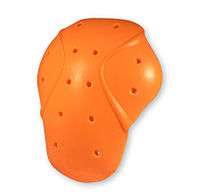D3o
D3O (formally "D3o") is a polyurethane energy-absorbing material containing several additives and polyborodimethylsiloxane[1] a dilatant non-Newtonian fluid.[2]
Polyborodimethylsiloxane[1] is a substance called a dilatant that in its raw state flows freely but on shock locks together to absorb and disperse energy as heat before returning to its semi-fluid state. The commercial material known as D3O is, in essence, a closed-cell polyurethane foam composite with polyborondimethylsiloxane (PBDMS) as the dilatant dispersed through the foam matrix[1] which makes the product rate-sensitive thus dissipating more energy than plain polyurethane at specific energy levels. The patent cites optimal proportions for a shock-absorbing foam composite formula: by volume, 15–35% of PBDMS and 40–70% fluid (the gas resulting from the foaming process, generally carbon dioxide) the remainder being polyurethane[3]. D3O's technology is found in many sports equipment such as body armour. British engineers Dr Phil Green and Richard Palmer discovered the material in 1999, first isolating it at the University of Hertfordshire. Palmer and Green went on to found the firm D3O Lab to develop and market the product.
History
The company commercialized the D3O material in 2006. In 2009, the UK Ministry of Defence awarded D3O Lab £100,000 to fit helmets in order to reduce the kinetic energy of a bullet or shrapnel on impact, because of its moldable properties.
D3O applications

D3O has been applied in the following areas:
- Military[4]
- Workwear
- Medical[5]
- Sports, including ski and snowboard, lacrosse, baseball, fencing, cricket,[6] volleyball, tennis, squash, ballet, boxing, shooting and sailing, mountain biking and cycling, equestrian and water sports[7]
- Motorcycle apparel
- Footwear
- Cases for electronic devices[8][9]
- Ice skating and figure skating[10]
Marketing
While D3o is a rate sensitive material, a goo used to demonstrate its properties is not D3o, as D3o is not processed in that way. Additionally, many products that claim to use D3o are PU foam. In majority of products, there is no PBDMS.
See also
References
- Palmer, Richard (2008). "Energy absorbing material". US Patent 7,794,827 – via USPTO.
- "Shock factor – d3o". physics.org. 27 May 2009. Archived from the original on 23 March 2012. Retrieved 7 September 2012.
- Richard Palmer & Philip Green for Design Blue Ltd, Shock Absorbing Material US patent 7,381,460 B2, https://patents.google.com/patent/US7381460
- Harding, Thomas (27 February 2009). "Military to use new gel that stops bullets". The Daily Telegraph. Retrieved 7 September 2012.
- "Hip Impact Protection Ltd is delighted to announce the launch of its innovative, next generation aid in the protection of hips of the frail and elderly, especially those with osteoporosis". hospital-technology.com. 15 March 2011. Archived from the original on 24 March 2012. Retrieved 7 September 2012.
- "d3o™". Gm-cricket.com. Archived from the original on 27 August 2012. Retrieved 7 September 2012.
- "Sports – D3O Lab". D3o.com. 15 September 2010. Archived from the original on 25 October 2010. Retrieved 7 September 2012.
- "The UK's No. 1 Protective Phone Cases featuring D3O® Technology". Gear4.com. Archived from the original on 1 August 2019. Retrieved 28 September 2017.
- "Grip Case >> dbrand". dbrand.com.
- "D30 Ice Skating Pants".